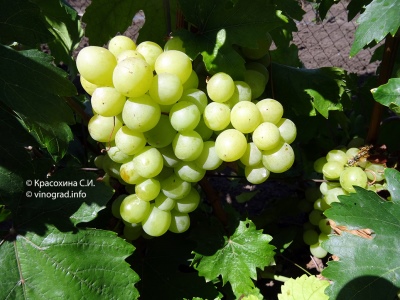
- Authors: Vishnevetsky Nikolay Pavlovich
- Berry color: White
- Taste: with a pleasant nutmeg and pear flavor
- Ripening period: very early
- Ripening period, days: 105
- Frost resistance, ° C: -24
- Bunch weight, g: 684, individual clusters reach 1000
- Flower type: bisexual
- Density of the bunch: dense and very dense
- Skin: medium
In the cultivation and distribution of different grape varieties, the merit is not only of scientific specialists. The average hobbyist can experiment with varieties and create real pride. Cultural plants, which are created by crossing resistant and productive varieties, are unique in size and taste.
Breeding history
In Ukraine, in Kirovograd, an amateur breeder has created a hybrid that is not inferior to varieties bred by professionals. Nikolai Pavlovich Vishnevetsky conducted a breeding experiment, crossing the Talisman and Zvezdny grapes. The new variety was named Valek. This grape proved to be resistant to the harsh climate, so it quickly spread through the vegetable gardens and orchards of Russia.
Description
A vigorous plant is resistant to changes in humidity or temperature, but does not like too moist soil. Usually rooted by cuttings. Strong vines grow rapidly and ripen evenly towards the end of the season.
Grapes can be transported over long distances without spoilage and loss of taste. The table grape variety is intended for fresh consumption, as well as for the mass production of white wine or natural juice.
Ripening period
A sufficiently early ripening period allows you to enjoy ripe berries in bunches already at the end of August. Inflorescences bloom in 10 days. Crop can be harvested 110 days after bud break.
Bunches
The very dense clusters are conical in shape. The average weight of one bunch is 684 g, individual clusters reach 1-2 kg.
Berries
Large white berries contain 170-190 g / dm3 of sugar and 5-6 g / dm3 of acidity. The weight of one berry is about 10.1 g, its length is 3 cm, and its width is slightly more than 2.5 cm. The fruits have a slightly oval or round shape. The skin is medium, felt on the teeth. The pulp is fleshy and juicy, in the core there are 2 bones.
Taste
Sweet with sour taste, well-pronounced nutmeg aftertaste. The skin is sweet and easy to bite.
Yield
Fruiting occurs in 2-3 years. The older the bush, the heavier its brushes and berries. Possesses great proliferation and high-yielding fruiting.


Growing features
The soil must be enriched with oxygen and regularly loosened, it must be periodically weeded, removing weeds. The irrigation system does not exceed 3 times a year (during dry periods up to 5 irrigations). The rest of the agricultural technology is similar to other grape varieties: site selection, fertilization, plant treatment, preventive measures against diseases and insects.
Landing
A freedom-loving culture is planted in a pit 80 cm deep.By strictly observing the distance of 3 meters between plantings, shading and chaotic ripening of berries can be avoided.
The plant does not develop in swampy soils. Landing on a hill, on a lighted, southern side with deep groundwater levels will accelerate the development process. Chernozem soil is considered favorable for the variety.
Valek can be planted along the walls, leaving a passage of more than a meter between them due to the peculiarities of its root system.
Watering
When watering the Valek variety, it is worth considering the correctness of the process. To water this culture, it is enough to slightly moisten the leaves, shoots and soil. To eliminate excess moisture, drainage of ground or storm water (drainage) is necessary.
Top dressing
In late autumn, before the onset of frost, a trench up to 50 cm is dug next to the bush. A mixture of 10 kg of rotted manure and 100 grams of pure wood ash is poured into it.

Pollination
The flower type is bisexual, therefore it does not require suitable species or pollinating insects next to it. Itself is considered a good pollinator of other varieties.
Pruning
The possibility of peas depends on the correct processing of Valek grapes. In early spring, before the buds bloom, pinch the top of the vine, remove the stepsons. After flowering, weak shoots break off. The growth of the bush stops, nutrients are redistributed among the bunches. In the fall, the plant is trimmed after leaf fall. The process gives shape to the bush for the correct ripening of the future crop.
Thinning of damaged leaves shading berries is done carefully. No more than 5 leaves can be removed from a branch.



Frost resistance and the need for shelter
The plant can withstand frosts down to -24 ° C, but young seedlings are better off hiding in winter. Mulching the roots with sawdust and a dense covering cloth will relieve the influence of frost. With the onset of above-zero temperature, the seedling is opened so that the sprout does not rot.

Diseases and pests
High resistance to fungal diseases and rot. Rarely affected by powdery mildew or mildew. During the ripening period, attention should be paid to driving off wasps. Not only insects, but also birds can encroach on crops.
To combat wasps, resort to the following measures:
- locating and disposing of hornets' nests nearby;
- catching pests with a special bait;
- using the net to protect the bush, it also helps keep birds away.

If a grape is exposed to any disease or insect, this always affects its appearance.
Storage
A dry, ventilated and cool room guarantees the preservation of fruits with cuttings for up to 3 months. The product can be stored in the refrigerator. The fruits are checked every 2 weeks, during the check they are sprayed with water. The affected berries are removed. If more than half of the brush is damaged, the entire bunch is discarded.











































































